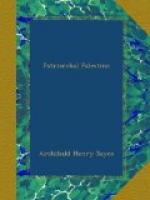If Jacob came to Shechem in peace, the peace was of no long continuance. Simeon and Levi, the sons of the patriarch, avenged the insult offered by the Shechemite prince to their sister Dinah, by treacherously falling upon the city and slaying “all the males.” Jacob was forced to fly, leaving behind him the altar he had erected. He made for the Canaanitish city of Luz, the Beth-el of later days, where he had seen the great altar-stairs sloping upward to heaven. The idols that had been carried from Mesopotamia were buried “under the oak which was by Shechem,” along with the ear-rings of the women. The oak was one of those sacred trees which abounded in the Semitic world, like another oak at Beth-el, beneath which the nurse of Rebekah was soon afterwards to be buried.
At Beth-el Jacob built another altar. But he could not rest there, and once more took his way to the south. On the road his wife Rachel died while giving birth to his youngest son, and her tomb beside the path to Beth-lehem was marked by a “pillar” which the writer of the Book of Genesis tells us remained to his own day. It indicated the boundary between the territories of Benjamin and Judah at Zelzah (1 Sam. x. 2).
At Beth-lehem Jacob lingered a long while. His flocks and herds were spread over the country, under the charge of his sons, browsing on the hills and watered at the springs, for which the “hill-country of Judah” was famous. In their search for pasturage they wandered northward, we are told, “beyond the tower of the Flock,” which guarded the Jebusite stronghold of Zion (Mic. iv. 8). Beth-lehem itself was more commonly known in that age by the name of Ephrath. Beth-lehem, “the temple of Lehem,” must, in fact, have been the sacred name of the city derived from the worship of its chief deity, and Mr. Tomkins is doubtless right in seeing in this deity the Babylonian Lakhmu, who with his consort Lakhama, was regarded as a primaeval god of the nascent world.
At Beth-lehem Jacob was but a few miles distant from Hebron, where Isaac still lived, and where at his death he was buried by his sons Jacob and Esau in the family tomb of Machpelah. It was the last time, seemingly, that the two brothers found themselves together. Esau, partly by marriage, partly by conquest, dispossessed the Horites of Mount Seir, and founded the kingdom of Edom, while the sons and flocks of Jacob scattered themselves from Hebron in the south of Canaan to Shechem in its centre. The two hallowed sanctuaries of the future kingdoms of Judah and Israel, where the first throne was set up in Israel and the monarchy of David was first established, thus became the boundaries of the herdsmen’s domain. In both the Hebrew patriarch held ground that was rightfully his own. It was a sign that the house of Israel should hereafter occupy the land which the family of Israel thus roamed over with their flocks. The nomad was already passing into the settler, with fields and burial-places of his own.




